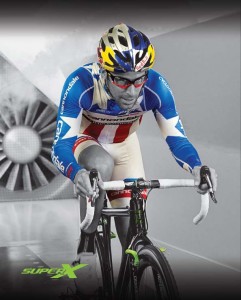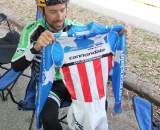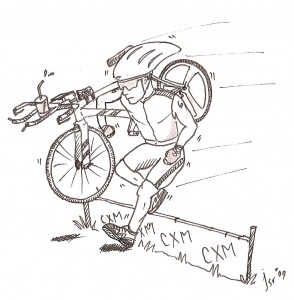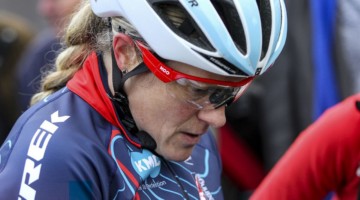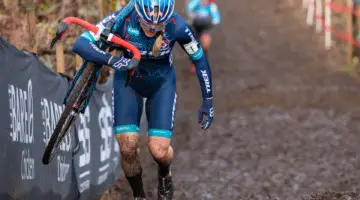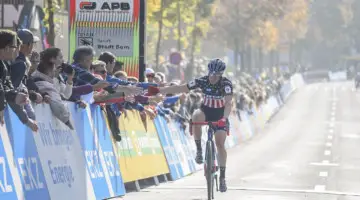Readers of Cyclocross Magazine in print saw an advertisement in Issue 10 from Cannondale featuring a photo of Tim Johnson in the wind tunnel aboard his new SuperX. While Johnson would not comment on the testing when we asked at the USGP Planet Bike Cup in Madison, I tracked down Mike Giraud of the A2 Wind Tunnel in Mooresville, NC – which Johnson used – to learn more about this project.
“Hey, we heard that you and Tim Johnson were working together in the wind tunnel – and he was on a ’cross bike! What’s up with that?” we asked.
Giraud was floored. He and Johnson had been working together on a secret project, applying aerodynamics to racing ’cross, but he’d thought no one had leaked the story. Obviously he was mistaken. Cannondale and Zipp had both procured photographs of the work and our mag had the evidence. Giraud spent most of Interbike fielding the same question, and the same skepticism:
“You don’t go fast enough on a ’cross bike for aerodynamics to be applicable.”
I ran into the same opinion myself, chatting with Dr. Kim Blair, PhD, who works at the MIT wind tunnel in Boston, MA.
“You really need to be going more than 20 MPH to see any real advantage,” he said. When I asked him if he saw any application for cyclocross (and he knows the sport, as he’s friends with Josh Anthony, brother of another Anthony who often graces these pages) he said, flatly, “No.” He talked about skill trumping aerodynamics in a sport like cyclocross, and how sacrificing a more stable body position for something more aerodynamic wouldn’t be a sensible trade-off.
Giraud, however, believes otherwise. “Cyclocross is intense start to finish,” he told me over the phone. “You’re burning up energy the whole time, and the way you set up your bike or equipment can make for small differences in aerodynamics, even at low speeds. Those small differences translate into small energy savings, since you’ll be doing slightly less work to go the same speed. You only need to win a ’cross race by half a wheel or so, right? If you can save some energy throughout a race and be stronger in that last lap, when everyone else is getting tired, well…” he trailed off, his assertion obvious. It’s not as quantifiable as doing time trial work, he says, but the science makes sense.
“There will be some section on most ’cross courses where you’ll probably approach 25 MPH,” he explained. “If you can save some energy at the same speed as your competitors through that 300 meters, and you do that section eight or nine times, we’re talking about a substantial saving in terms of work performed.”
I asked Giraud for some specifics about the work he’d been doing with Johnson, but he demurred. He did, however, offer me an example of what they’d been doing. I brought up a popular ’cross style of riding in the drops with your torso more upright than a road position and he posed an aerodynamic alternative. “Instead of riding in the drops, move your hands to the hoods without changing the angle of your torso, so your arm has a 90 degree bend in it. That section of your forearm which used to be seeing more of the wind is now facing directly into the wind, so you’ve decreased the frontal area and improved your aerodynamics and ability to save energy. That’s the kind of thing we were looking at.”
With the addition of this year’s day-before time trial at Nationals, perhaps racers are searching for every possible advantage going into the biggest domestic race. Questions about that intention, though, should be moot for Elite riders. Johnson, as defending champion, will be called to the front of the field, as will all of the UCI point leaders. Johnson, for his part, was silent when we asked him at the Planet Bike USGP for details about the experiment.
Giraud stressed that this project was exploratory, more a possibility of things to come than practices Johnson will put into place this year. Again, Giraud didn’t want to speak about specific things they’d learned, but he was willing to share one surprise: there’s very little difference in the aerodynamic qualities of ’cross tires. He sees huge differences in road tires, wild fluctuations in drag numbers from subtle differences in tread patterns. He and Johnson supposed that ’cross tires would be similar, but it turns out they’re all about the same aerodynamically: terrible. “’cross tires just mess the wind up so badly, because of their width and relative aggressiveness compared to road tires, that there’s really no difference between the different tires. No difference that would influence tire choice over the conditions at the race, anyway.”
Katie Compton, who I managed to drag into this conversation, remained skeptical, choosing to talk about the primacy of conditions over aerodynamics. “Sure,” she said. “There are always some road sections on which you’ll be going above twenty miles an hour, but when you’ve got your tire pressure running around 20-22psi, you’ve got such huge rolling resistance that you won’t make big gains by being more aero. Also, the road sections are where people usually sit up a little bit, look around to see where their opponents are at. I think you’ll see more advantages by being able to roll through technical sections quickly, having that feel of the bike underneath you. That’s something that’s kind of hard to teach. I mean, I love my deep dish rims—I don’t race on anything else—but I love them for their ability to cut through mud and for their wider rims (and gluing surfaces) rather than any aerodynamic qualities.”
Giraud is hopeful, however, about the future of aerodynamics in ’cross. “I think there’s going to be a big surge of development in the sport,” he says, citing the growth of cyclocross in the US. “Bikes are getting so light now that manufacturers are willing to add a little weight for aero qualities. In ’cross, weight is king—you’ve got to pick up the bike, run with it, you know—and ten or so years ago you wouldn’t have seen anybody sacrificing weight savings for aerodynamics. But today you have to add weight to some bikes to get to a minimum, so why not make your frame more aerodynamic? I mean, if this stuff holds up, if we see there is an energy savings in being more aerodynamic, other racers out there are going to start saying ‘Hell, I gotta start doing this. I can’t spot him five to ten seconds.’ So we’ll see.”













